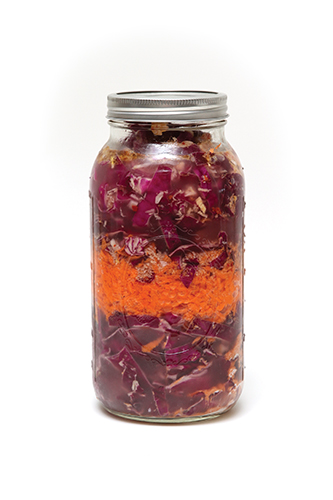
Kimchi is the funky, spicy, ancient Korean fermented cabbage dish that’s being rediscovered by chefs today. While traditional kimchi takes months to make, our lacto-fermented kimchi is ready in days because it cooks the vegetables enzymatically. (Microorganisms work with enzymes, a chemical catalyst, to “predigest” your food.) It’s full of healthy probiotics and vitamin C. And did I mention it’s delicious and inexpensive?
Living and Fermented Foods
My partner Mikey Sklar and I are fans of fermentation fetishist Sandor Ellix Katz (wildfermentation.com), author of some great books including Wild Fermentation: The Flavor, Nutrition, and Craft of Live-Culture Foods and The Art of Fermentation. Sandor advocates eating foods that have active bacteria and contain enzymes symbiotic to our body’s flora. He describes some of the benefits of living foods as follows:
Digestion: microorganisms break down nutrients into more digestible forms
Nutrition: microbial cultures create vitamins through conversion
Protection: many organisms protect us from more harmful organisms and substances
Preservative: they produce alcohol and lactic and acetic acids
Fermented and living foods are often impossible to find in stores. Laws that require foods to be pasteurized (heated to temperatures that kill bacteria and make enzymes inactive) make some live foods illegal: unpasteurized milk, for example, is illegal in most states. If you want to eat living foods, it’s best to raise your own cultures. If you’re new to fermentation, be sure to grab a good guidebook for tips on how to work safely in the world of microorganisms.
Most of the food produced in America is manufactured and processed by large-scale systems, and so pasteurization is an accepted standard and law for dairy products. Honey, fruit juice, cheese, and yogurt are commonly pasteurized, but there is no legal requirement to do so.
We’ve found it safe and enjoyable to live with microorganisms. We have obtained microorganisms — bacteria, yeast, and fungus — on the Internet, networked to get them from friends, and traded them. Cultures are part of our domestic economy. Here are some of the microorganisms we keep alive in our kitchen. Mesophilic organisms thrive at moderate tempratures, and thermophilic organisms thrive with heat.
(Excerpted from The Good Life Lab © Wendy Jehanara Tremayne. Used with permission of Storey Publishing)
Read about MAKE intern Paloma Fautley’s adventures chasing down uncultured whey to make kimchi.








